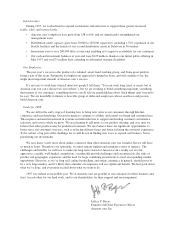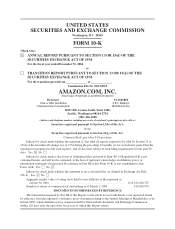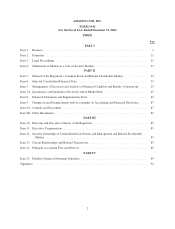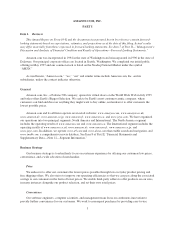Amazon.com 2004 Annual Report Download - page 18
Download and view the complete annual report
Please find page 18 of the 2004 Amazon.com annual report below. You can navigate through the pages in the report by either clicking on the pages listed below, or by using the keyword search tool below to find specific information within the annual report.•restrictions on sales of certain products or services and uncertainty regarding our liability for the
products or services we offer and content provided by us or our users, including uncertainty as a result
of less Internet-friendly legal systems, local laws, lack of legal precedent, and varying rules, regulations,
and practices regarding the distribution of media products and enforcement of intellectual property
rights;
•import, export or other business licensing requirements;
•limitations on the repatriation of funds and foreign currency exchange restrictions;
•difficulty in obtaining distribution and support;
•nationalization or restrictions on foreign ownership;
•shorter payable and longer receivable cycles and the resultant negative impact on cash flow;
•consumer and data protection laws and restrictions on pricing or discounts;
•lower levels of adoption or use of the Internet and other technologies vital to our business and the lack
of appropriate infrastructure to support widespread Internet usage;
•lower levels of consumer spending on a per capita basis and fewer opportunities for growth in certain
foreign market segments compared to the U.S.;
•lower levels of credit card usage and increased payment risk;
•difficulty in staffing, developing and managing a number of unique foreign operations as a result of
distance, language and cultural differences;
•different employee/employer relationships and the existence of workers’ councils and labor unions;
•laws and policies of the U.S. and other jurisdictions affecting trade, foreign investment, and loans;
•tax and other laws of the U.S. and other jurisdictions; and
•geopolitical events, including war and terrorism.
As the international e-commerce channel continues to grow, competition will likely intensify. Local
companies may have a substantial competitive advantage because of their greater understanding of, and focus on,
the local customer, as well as their more established local brand name recognition. In addition, governments in
foreign jurisdictions may regulate e-commerce or other online services in such areas as licenses, content, privacy,
network security, copyright, encryption, taxation, or distribution. We may not be able to hire, train, retain,
motivate, and manage required personnel, which may limit our growth in international market segments.
If We Do Not Successfully Optimize and Operate Our Fulfillment Centers, Our Business Could Be Harmed
If we do not successfully operate our fulfillment centers, it could significantly limit our ability to meet
customer demand. Because it is difficult to predict demand, we may not manage our facilities in an optimal way,
which may result in excess or insufficient inventory, and warehousing, fulfillment, and distribution capacity. A
failure to optimize inventory in our fulfillment network will increase our net shipping cost by requiring us to
make long-zone shipments or partial shipments from one or more locations. Orders from several of our
internationally-focused websites are fulfilled primarily from a single fulfillment center, and we have only a
limited ability to reroute orders to third parties for drop-shipping. We and our co-sourcers may be unable to
adequately staff our fulfillment and customer service centers. As we continue to add fulfillment and warehouse
capability or add new businesses with different fulfillment requirements, operating our fulfillment network
becomes more challenging and there can be no assurance that we will be able to operate our network effectively.
We rely on a limited number of shipping companies to deliver inventory to our fulfillment centers and
completed orders to our customers. If we are not able to negotiate acceptable terms with these companies or they
10
























